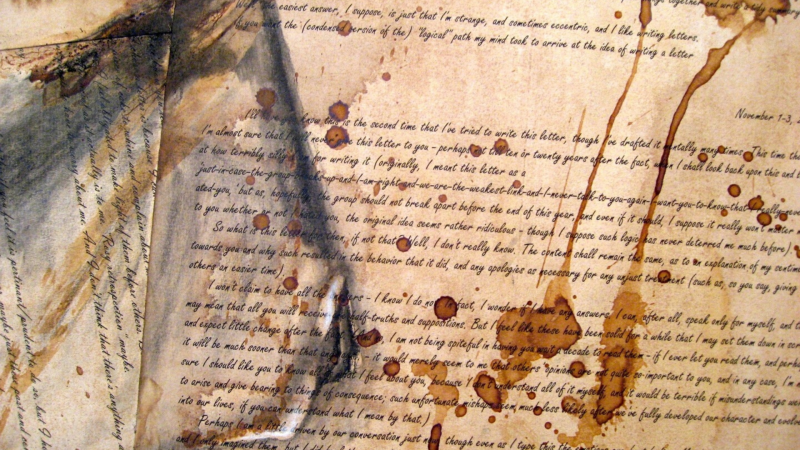
Researchers show that the shape of dried paint or ink deposit is related to the concentration and size of particles in these colloids.
Ever wondered why we use only specific inks for the inkjet printer? Why not any random dye? The wrong ink may result in non-uniform and patchy printing. Printing inks are colloids—tiny solid particles suspended in a liquid. The size and the concentration of the solid particles in ink specified for printers are designed to deposit uniformly on paper.
Just like ink, paints and some medicines are colloids. One can determine if blood—also a colloid—is healthy or not, by looking at the dried stains. Colloids, like that of copper, are used in electronics, where they can be deposited on circuit boards to make uniformly thin tracks by controlling the size and concentration of copper particles.
Prof Rajneesh Bhardwaj and his group at the Indian Institute of Technology Bombay (IIT Bombay) study colloidal deposits and the various factors affecting their characteristics. The deposits formed when colloids dry on a solid surface have specific shapes and thickness. In a recent study in collaboration with Monash University, Prof Bhardwaj and team investigated how the concentration and the size of the suspended particles in a colloid affected these deposits. They found that the deposits were more likely to crack for a higher concentration of the solid in the colloid. Many layered deposits would form when the concentration was higher and the size of the suspended particles smaller.
The problem Prof Bhardwaj has addressed is similar to the old coffee-ring problem. You would have noticed that on a coffee stain, the colour at the periphery is darker than the centre. It is because most of the particles accumulate near the edge as the droplet dries. Many colloids form similar ring-shaped stains, irrespective of the solid and liquid materials that form the colloid.
The researchers of the current study used colloidal solutions of polystyrene beads in water and observed how its droplets deposited on clean glass slides. Why polystyrene?
“Polystyrene beads are model particles. Their density is equal to that of water,” shares Prof Bhardwaj. Hence, the beads stay uniformly mixed in water and don’t settle down.
The researchers observed that rings were thicker when the colloids had higher concentration. The cracks in the deposits became prominent with smaller sized particles.
“When the droplets begin to dry, the polystyrene particles stick to the glass surface. As they dry further, these particles feel mechanical stresses that lead to cracks in the deposits. As bigger particles have more space between them, they feel less stress and don’t crack,” explains Prof Bhardwaj.
Further, the researchers observed three different patterns in the deposits; broken single-layered rings, continuous single-layered rings and multiple-layered rings. Larger particles at lower concentrations form broken single-layered rings, while at higher concentration form continuous single-layered rings. Smaller particles at higher concentration and larger particles at very high concentrations form rings with multiple layers. They also examined the rate at which the colloidal particles deposited at the periphery and found them fitting well with existing mathematical models.
The boundary of a droplet on sticky, water-attracting surfaces like glass, remains fixed due to a phenomenon called ‘pinning of the contact line’. Water on a nonstick or water-repellent surface does not have such a pinned contact line.
“Pinning is determined by the friction between the surface and the liquid,” says Prof Bhardwaj. Colloidal deposits are ring-shaped when the contact line is pinned. A droplet is thick at the centre and thin at the periphery as the liquid from the edge evaporates quickly. “Since the contact line is pinned and the radius of the drop can’t shrink, the liquid from the centre flows outwards to the periphery to replenish the liquid. This flow carries with it solid particles dispersed in the droplet, which make the ring,” explains Prof Bhardwaj.
The researchers created a chart to predict whether a colloid deposit would be single-layered or multiple-layered and cracked or not, based on the colloidal particles’ size and concentration. This chart can be used to fine-tune the colloidal parameters for a particular application.
“A long term goal of this project is to fabricate a uniform deposit rather than a coffee ring which is useful for applications in inkjet printing and bioassays,” adds Prof Bhardwaj.
Now the next time you stare at a blank wall and wonder why the paint (a colloid) doesn’t crack, you can guess that the particles in the paint are large enough and that the concentration is adjusted to set the optimum thickness of the coating.
An interesting fact-
Prof Bhardwaj points out how the coffee-ring problem is mathematically similar to many other everyday questions. If you observe, you can see that french fries are darker on the edges. They exchange more heat at the edges when in the hot oil bath than at the centre. This heat transfer is mathematically similar to how the concentration of liquid vapour outside an evaporating droplet changes. Charge accumulation along the edges of a lightning arrester is also identical. One needs to solve the same Laplace equation to find the heat, concentration of vapour and charge density. There is a universality that binds the science used in the very different fields concerning heat, colloids and charges.
This article has been run past the researchers, whose work is covered, to ensure accuracy.






